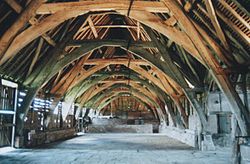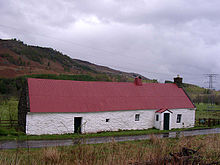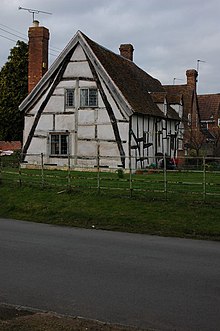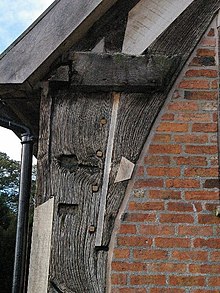Cruck


A cruck or crook frame is a curved timber, one of a pair, which supports the roof of a building, used particularly in England. This type of timber framing consists of long, generally naturally curved, timber members that lean inwards and form the ridge of the roof. These posts are then generally secured by a horizontal beam which then forms an "A" shape. Several of these "crooks" are constructed on the ground and then lifted into position. They are then joined together by either solid walls or cross beams which aid in preventing racking (the action of each individual frame going out of square with the rest of the frame, and thus risking collapse).
The term crook or cruck comes from Middle English crok(e), from Old Norse krāka, meaning "hook". This is also the origin of the word "crooked", meaning bent, twisted or deformed, and also the crook used by shepherds and symbolically by bishops.
Crucks were chiefly in use in the medieval period for structures such as large tithe barns. However, these bent timbers were comparatively rare, as they were also in high demand for the ship building industry. Where naturally curved timbers were convenient and available, carpenters continued to use them at much later dates. For instance, base crucks are found in the roofs of the residential range of Staple Inn Buildings, Nos. 337 – 338, High Holborn, London. This is dated by documented records to 1586, with significant alterations in 1886 (under Alfred Waterhouse) and further restorations in 1936, and 1954–55. Despite these changes, an authority on English Historic Carpentry, Cecil Hewett, has stated that these 16th-century crucks are original.
During the current revival of green oak framing for new building work, which has occurred mainly since approximately 1980 in the UK, genuine cruck frames have quite often been included in traditionally carpentered structures.[1] There are also some fine, historically authentic reconstructions. For instance, Tithe Barn, Pilton, Glastonbury, whose original roof was destroyed by lightning, has been carefully rebuilt in 2005 from curved oaks. The necessary trees were sought out, using special templates, in English woodlands.
The large main barn of the manor house Barlow Woodseats Hall features what is claimed to be the longest continuously roofed cruck barn in Derbyshire, and possibly even in the United Kingdom.
No cruck frames are known to have been built in America though there are rare examples of what may be an upper cruck or knee rafters. Rare examples of cruck framing are found on continental Europe such as in Belgium,[2] Flanders, Northern France and the Corrèze region of France.[3]
An example of a Yorkshire cruck barn complete with a heather thatched roof can be found in Appletreewick.[4] The crucks or cruck "blades" are a single oak tree riven (split) in two to form an equally shaped A frame.
Types of crucks

- True cruck or full cruck: The blades, straight or curved, extend from a foundation near the ground to the ridge. A full cruck does not need a tie beam and may be called a "full cruck -open" or with a tie beam a "full cruck - closed".[5]
- Base cruck: The tops of the blades are truncated by the first transverse member such as by a tie beam.[5]
- Raised cruck: The blades land on masonry wall and extend to ridge.[5]
- Middle cruck: The blades land on masonry wall and are truncated by collar beam.[5]
- Upper cruck: The blades land on tie beam, very similar to knee rafters.[5] In Dutch called a kromstijlgebint.[6]
- Jointed cruck: The blades made from two pieces joined near eaves. They can be joined in at least five ways.[7]
The apex of a cruck frame also helps to define the style and region of the cruck. Different types include the butt apex, halved, housed, yoke, and crossed forms.[7]
See also
References
- ^ Ross, P.; Mettem, C.; Holloway, A. (2007). Green Oak in Construction. High Wycombe: TRADA Technology. pp. 8–9, 14, 57, 112–3. ISBN 978-1-900510-45-5.
- ^ Alcock, Nat (June 5, 2011). "The Significance of the Cruck Construction at Néchin, Belgium". L'architecture vernaculaire.
- ^ "La charpente à cruck" (in French).
- ^ Craven Cruck Barn
- ^ a b c d e Brown, R. J. (1997) [1986]. Timber-framed buildings of England. London: R. Hale. pp. 66–67. ISBN 0709060920.
- ^ Herman Janse (1989). "Houten kappen in Nederland 1000-1940" (in Dutch). Retrieved January 4, 2013.
- ^ a b Brown, R. J. (1997) [1986]. Timber-framed buildings of England. London: R. Hale. p. 68. ISBN 0709060920.
Further reading
- Hewett, Cecil A. (1980), English Historic Carpentry, Philimore, pp 231–233. ISBN 0-85033-354-7
- Harris, Richard (1978), Discovering Timber-Framed Buildings, Shire Publications Ltd. Princes Risborough, Buckinghamshire. ISBN 0852634277
- Alcock, N. W., Barley, M. W. et al (1996), Recording timber-framed buildings - An illustrated glossary, Council for British Archaeology, York. ISBN 1872414729
External links

